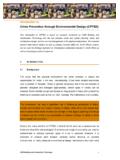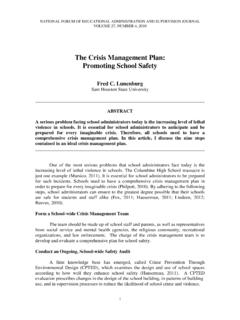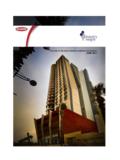Transcription of CHAPTER Environmental 3 Criminology
1 CHAPTER97 KEY TERMSA ctivity SpaceAwareness SpaceCPTEDC rime DisplacementDefensible SpaceDiffusion of BenefitsEvent DependencyHedonismRisk HeterogeneityVictim FacilitationVictim PrecipitationVictim ProvocationVirtual RepeatsEnvironmental Criminology3 LEARNING OBJECTIVESC hapter 3 continues the discussion on theories of crime causation but narrows the scope to theories and approaches that use both individual behaviors and physical characteristics of space to explain crime. As discussed in the previous CHAPTER , the physical characteristics of an environment communicate social clues to the people who live, work, and play there. These clues provide poten-tial offenders and victims with information about how they should behave to ensure their safety, pleasure, and the successful fruition of their interests. For offenders, these clues identify the method by which they might commit a crime successfully and avoid getting caught. For potential victims, these clues provide information about how to avoid being victimized.
2 This CHAPTER reviews several theoretical approaches that are used in developing Environmental design aspects to prevent crime. These aspects include lighting, landscaping, natural surveil-lance and crime prevention boundaries, and building design, to name a few. After studying this CHAPTER , you should be able to: Identify and explain core elements to cpted approaches. Explain the basic tenants to rational choice perspectives. Explain the Crime Pattern Theory. Explain and discuss the Routine Activities Theory and its utility in understand-ing and analyzing crime. Discuss lifestyle exposure approaches and understand their utility in under-standing repeat offenses and repeat victimization. List and describe the types of crime displacement, and discuss the relevant research that examines the existence (or lack) of crime displacement. Explain the concept of diffusion of benefits and its utility in understanding crime 3 continues the discussion on theories of crime causation but narrowsthe scope to theories and approaches that use both individual behaviors and physical characteristics of space to explain crime.
3 As discussed in the previous CHAPTER , the physical characteristics of an environment communicate social clues to the people who live, work, and play there. These clues provide poten-tial offenders and victims with information about how they should behave to ensure their safety, pleasure, and the successful fruition of their interests. For offenders, these clues identify the method by which they might commit a crime successfully and avoid getting caught. For potential victims, these clues provide information about how to avoid being victimized. This CHAPTER reviews severaltheoretical approaches that are used in developing Environmental design aspectsto prevent crime. These aspects include lighting, landscaping, natural surveil-lance and crime prevention boundaries, and building design, to name a few. Afterstudying this CHAPTER , you should be able to: Identify and explain core elements to cpted approaches. Explain the basic tenants to rational choice perspectives.
4 Explain the Crime Pattern Theory. Explain and discuss the Routine Activities Theory and its utility in understand-ing and analyzing crime. Discuss lifestyle exposure approaches and understand their utility in under-standing repeat offenses and repeat victimization. List and describe the types of crime displacement, and discuss the relevantttresearch that examines the existence (or lack) of crime displacement. Explain the concept of diffusion of benefits and its utility in understandingscrime 2 discussed several theoretical frameworks that identify the social and physical incivilities that are important in understand-ing community-level crime rates. These theories emphasize the flaws in the physical environment and the gaps in social networks that are 972/4/09 11:48:07 AM2/4/09 11:48:07 AM Jones and Bartlett Publishers, LLC. NOT FOR SALE OR CHAPTER 3 Environmental Criminologycommon to high-crime areas. These theories also identify characteristics of individuals who are typically found (residing or working) in socially disorganized neighborhoods.
5 This CHAPTER narrows our focus to the individual characteristics and the physical properties of space related to crime and victimization through the creation of increased opportunities for motivated offenders to commit crime. Every person has routines and rhythms of their daily lives that become part of us. Have you ever been so absorbed by a project at work that on some Saturday or Sunday your significant other has asked you to run an errand, and you found your-self on the way to work or even pulling into the place where you work when you had intended to go to the store? That drive back and forth to work has become an important part of your social makeup. On our way to our activities and employment, we may look around and see a new construction site and ask ourselves, I wonder what they are building there? People who are prone to crime and hunting for targets does the same thing, only their question might be, I wonder if that compressor is locked up or if I could steal it later tonight?
6 Using Environmental design to control human behavior is not only popular in developing crime prevention efforts; it is also used in the pri-vate sector to increase profit margins. Casinos, for example, are strategi-cally designed to keep people gambling for as long as possible. Big casinos incorporate several design aspects to keep customers happy, comfortable, and gambling. For example, carpets exhibit bright, elaborate, and fun designs, while pumped-in oxygen, mirrors, and bright lights create a stimulating environment that makes it difficult to be bored or sleepy. Alcoholic drinks are also served 24 hours a day, often free of charge, to gambling patrons by casino staff members who are typically dressed in barely there outfits. Event halls and auditoriums are located adjacent to gambling areas, requiring patrons to walk through those areas upon arrival and departure. Even arrival to and departure from the Las Vegas airport requires people to walk past slot machines!
7 One does not have to look further than a local supermarket to grasp the concept of Environmental design and how it impacts human behavior. In another example outside of criminal justice, to pick up a gallon of milk at a grocery store, customers must walk to the far corner of the store, usually past impulse and convenience food items, to reach the milk section. Knowing that people are likely to pick up milk on their way home from work (and are probably hungry and tired), the store places various snack foods and ready-to-eat items on the path to commonly needed items (such as milk) in an effort to increase sales. 982/4/09 11:48:19 AM2/4/09 11:48:19 AM Jones and Bartlett Publishers, LLC. NOT FOR SALE OR DISTRIBUTION. Introduction 99 The notion of physical design to control behavior, particularly criminal behavior, is also not new.
8 Attention in both the academic and practical realm shifted to the physical environment and how it could be modified to control human behavior when crime increased exponentially in the late 1960s and early 1970s. Jane Jacobs (1961) was one of the first researchers to propose a relationship between crime and the urban city environment. In her book The Death and Life of Great American Cities, she made several observations about crime and the physical environment. She was also one of the first to suggest that the physical environment could be manipulated by improving the natural surveillance (the ability of the persons living in an area to be aware of what is going on in their portion of the neighborhood) of an area to reduce crime. Other researchers during this time period, including Elizabeth Wood (1961) and Schlomo Angel (1968), focused their research on the effects the physical environment could have on human behavior and how environments could be manipulated to achieve social point to Environmental design is to guide, manipulate, and/or encourage people to behave in a desirable manner in a given situ-ation.
9 In neighborhood crime control strategies, this can mean a variety of things. First, the environment needs to be created in a way that encourages informal social control efforts by the people who work and reside in a neighborhood. An example of informal social control is the existence of a block watch group in a neighborhood. All of the neighbors actively participate in reporting, interceding, or watching their portion of the neighborhood for criminal or socially unacceptable behavior. They cannot literally arrest someone, in most cases, but they can give the impression to unauthorized persons in the neighborhood that everything they are doing is being watched and will be reported to the police. Second, the physical properties of a space should allow for maximum visibility so that residents can observe what is happening in their surroundings. Third, environmen-tal clues emanating from the neighborhood should send the message to outsiders and potential offenders that committing crimes in this place would be risky and unprofitable.
10 A very important point here is that the interaction of physical design and informal social control are what creates an environment that is resistant to crime. If the environment cannot control human behavior in the way in which it was intended, the design aspects examined in this CHAPTER will likely have few affects on 992/4/09 11:48:19 AM2/4/09 11:48:19 AM Jones and Bartlett Publishers, LLC. NOT FOR SALE OR CHAPTER 3 Environmental CriminologyThe cpted ApproachLet us first examine crime prevention through Environmental design ( cpted ) approaches. cpted suggests that the design of physi-cal space is important in understanding criminal behavior. C. Ray Jef-frey (1971) and his contemporary Oscar Newman (1972) are credited with providing the foundations that outline how physical space should be designed to maximize its crime prevention s Defensible SpaceThrough the Safe Streets Act of 1968, grant funding was made available to research new crime-prevention efforts.














